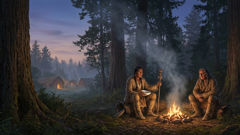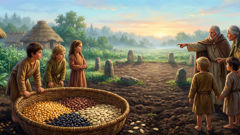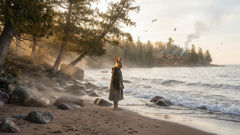Introduction
On frost-bright evenings when December leans its weight into the valleys and the sheepfolds hush, something stubbornly human slips into the lanes of Welsh villages: a pole, a skull, a chorus of bells and laughter. The Mari Lwyd arrives wrapped in ribbons, a horse's empty eyes reflecting lantern glow, a mockery and a marvel at once. She is led by a small troop — young men in old coats, voices low with practiced cadence — who move like shadowed players in a living pageant. In houses the firelight steadies, kettles hum, and doors crack open to a ritual that is part wassail, part puzzle, part theatrical audition. The Mari Lwyd knocks — not with knuckles but with rhymes — and a battle of wit begins. This is less a war and more a conversation between worlds: the householders who shelter warmth and the visiting skull that insists upon entry, receives a welcome, or departs unsatisfied. The custom continues to haunt, enchant, and provoke curiosity, combining playful mock-threats with a deep-rooted appeal to hospitality. Its verses are a kind of key, and its gestures ask a village to remember, to forgive, to share bread and ale. In exploring this tradition I am not only recounting a performance; I am walking with those who carry the Mari Lwyd, naming the ribbons and the rhymes, and listening for how communities have transformed an old, creaking ritual into a living, evolving custom—one that still collects laughter and glances in the dim glow of winter nights.
Origins, Anatomy and the Logic of a Skull
The Mari Lwyd wears the visible outline of something once ordinary and now uncanny: a horse skull fixed to a pole, often padded with a cloth or old coat to suggest a neck, with glass, foil, or small mirrors set in the empty sockets to make eyes that catch firelight. Around the skull hang ribbons, sometimes bells, often sprigs of holly or ivy, and the pole-bearer—who may stoop so the skull appears to be nodding—becomes both puppet and spirit. Simple as it looks, the Mari Lwyd's anatomy is logic turned into image. The skull announces an absence: the animal is gone, yet its head insists upon movement, voice, and appetite. There is humor and horror in that insistence; it asks in a single, theatrical gesture what the living owe to the dead, what the seasons owe to ritual, and what a community owes to itself.
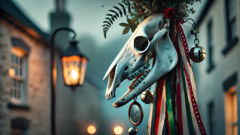
Historically, tracing the Mari Lwyd requires strolls through parish records, antiquarian notes, and the memories of those whose grandparents once trod the lanes. The custom has been observed most commonly in south Wales—Gwynedd, Glamorgan, Monmouthshire—though versions appear elsewhere in the British Isles and beyond, where skulls and parading effigies answer seasonal need in their local tongues. Some antiquarians of the nineteenth century tried to pin its origin to pre-Christian rites, to suggest that skulls and animal heads were sacrificial relics of a dark, primeval worship. Others offered a more prosaic account: that the ritual is a form of wassail, a mobile request for food, drink, and good will, wrapped in performance and poetry so hosts will respond with generosity rather than mere politeness. Both interpretations capture elements of truth; the Mari Lwyd lives at the intersection of deep memory and practical social custom.
Beyond any single theory, the Mari Lwyd's logic is ritual economy. In winter's lean days, bodies gather heat through stories, food, and shared tasks; door-to-door visits compact exchange into a memorable encounter. The Mari Lwyd does not merely demand hospitality: she tests a household's generosity with nonsense questions, paradoxical riddles, and an almost courtroom-like succession of verses known as pwnco. In those rhymes, the skull plays prosecutor, judge, and jester. The householder replies, attempting to out-rhyme, out-wit, or out-sing the skull's demands. Success often means admission—an allowance of space by the hearth—failure can mean playful banishment. It is crucial to understand that these exchanges are not meant to harm; they are a ritualized contest where social bonds are strengthened because both sides accept the rules and ultimate goodwill.
The Mari Lwyd's actual words vary—lines handed down in coastal Cadwaled regions differ from those of upland farming communities—and that variance is a map of living practice. One village might favor a stern, teasing voice from the skull, while another's Mari is leaned into comic provocation. Certain motifs recur: the skull's claim for entrance, its jests about the household's state, the householder's refusal and eventual concession, aided perhaps by sweet treats or a dram of whiskey. Once admitted, the Mari Lwyd may be led around the room, be offered bread or a cup, and the ritual closes with laughter, an exchange of small gifts, or the Mari's ceremonial departure. This economy of verse and gift means households preserve not only food for winter but also the cultural materials—rhymes, gestures, items—that mark them as part of a local narrative.
Collectors who documented the Mari Lwyd in the nineteenth and early twentieth centuries recorded numerous incidental details that reveal the ritual's texture: the way participants would snuff out candles to make the skull's eyes gleam; the polite restraint of women who watched, often from behind curtains; the role of the 'captain' who kept the verses flowing; the occasional bitter-sweetness when a Mari Lwyd performance served as a social valve for young men who had limited outlets for mischief. It was both an excuse for revelry and a public rehearsal of social norms. Even when repressive voices in the past criticized the custom as rowdy or irreligious, that criticism demonstrates how the Mari Lwyd touched nerves: its appearance in the doorway was an embodied reminder that community could be both playful and unruly.
What of symbolism? The horse is an animal of power and labor in agrarian Wales. To carry its skull at midwinter is to summon, briefly and playfully, the force that has helped plough fields and haul harvests. The skull's cold, toothless grin is less a portend of doom than an inverted mirror for villagers to look into and see their own response to scarcity and to the year's turning. In more modern readings the skull speaks to continuity: a community chooses to keep a fragile practice alive, to craft an object of reverence and ridicule, and to pass it along as if saying, 'We remember who and what we were; we will continue to be together.'
A careful observation of the Mari Lwyd's anatomy and the ways communities have adapted it teaches a larger lesson about folklore itself: traditions are not fossils but conversations across generations. When the Mari Lwyd steps into a doorway and speaks, she is using an old language made new with each voice that leads her. The skull is the prop, the verses are the glue, and the warmth inside the house is the reason the custom keeps returning each winter.
A Night at the Door: Verses, Wit and Community
The sound of the Mari Lwyd arriving in a hamlet is not a single thing but a layered event: the scrape of boots in snow, a muffled laugh, the clink of metal on bone, a low cadence of rehearsed lines. To be present on such a night is to feel how atmosphere and expectation braid together. The skull does not simply request admittance with brute force; it brings ritual language—pwnco—that bends a host's sense of propriety into a participatory performance. Imagine a cold, bright evening. A family sits around a kitchen table; a pot simmers, children press their noses against windowpanes, and someone has left the back door unlatched in case the Mari Lwyd calls. The knock is not wood; it is verse: the carrier recites, the skull's head jerks as though to emphasize certain words, and the household must answer in kind.
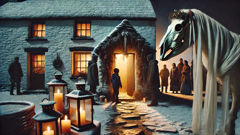
Pwnco is a verbal sport. One side throws a line—sometimes teasingly accusatory, sometimes pleadingly absurd—and the other is obliged to return a counter-line that meets both rhyme and meaning. The skull might intone: 'Open the door, the night is cold; give me shelter, give me gold.' The household replies with a refusal couched in wit: 'No welcome for skulls, no feast tonight; our home is closed, our hearth not light.' The skull pushes, the household refuses, then negotiation begins to take on the shape of a dance: playful threats turn into bargains, sarcasm into hospitality. The terms are not fixed. Some towns have an agreed sequence; others improvise, and the best moments are those when speech is clever enough to make both sides laugh, to transform the confrontation into communal delight. When the Mari Lwyd finally wins—usually by charm, often by acceptance—the household opens, and the ritual moves inside, where it is guaranteed to accumulate heat and story.
There are nights when the Mari Lwyd's arrival echoes deeper social needs. In times when young men had little social freedom, parading the skull and testing a household's patience allowed a public stage for youthful energy. In times of economic strain, the custom could be a gentle pressure on households to share. In modern contexts, the Mari Lwyd has become a site of cultural memory and deliberate revival. Community groups, historical societies, and theatre collectives have taken up the practice, sometimes adapting it with new verses that reflect contemporary concerns: environmental anxieties, migration, local identity. This reworking shows how the custom is not fixed; it evolves as communities negotiate which parts of their past they want to carry forward and how to make those parts speak to the present.
A close listening on such nights reveals the distinct roles people take: the pole-bearer who keeps the skull moving at exactly the right pace; the 'controller', who shushes a noisy helper when a crucial line is about to be delivered; the elderly listener who corrects a verse from memory; the child who clings to an adult's hand because the skull's teeth look real. Women, for reasons that varied historically across villages, often watch and judge a performance from the margin, carrying the authority that comes from being the household's custodian. In contemporary revivals, roles have been flattened and reversed; women and men both carry the Mari, children are taught its verses at schoolyards, and the ritual becomes an inclusive act of heritage rather than the narrower social release it once was.
Verses themselves are full of small, cunning moves designed to test. A Mari Lwyd line might be deliberately nonsensical, designed to elicit a laughter-laced rebuttal, then suddenly shift into a serious, almost pleading line about the cold or hunger as if to remind the household of the season’s hardship. That switch between jest and sincerity is where ritual gains moral power: it makes the household face the human need beneath the performance. The household's response might be to offer a bit of bread or a cup, acknowledging that rituals are social currencies. Throughout Wales, variations of this exchange highlight how economic realities inflect the Mari Lwyd. In wealthier times the prize might be a generous spread; in leaner years a bowl of porridge sufficed. The important act is the offering itself: recognition that the outsider, even a skull on a pole, is part of a circuit of mutual obligation.
Modern retellings of the Mari Lwyd often stress the theatrical, but it's crucial not to lose sight of the intimacy at the hearth. When a household finally admits the Mari Lwyd, space is made—space for story, for song, for an odd kind of blessing. The skull becomes a comic priest, a test that blesses the home by exposing its willingness to share. In the morning, neighbors might gossip not about whether the skull behaved but about the humor of certain lines, the bravery of a timid child who returned a rhyme, the deftness of an elderly woman who taught a correction. The custom, in this way, produces narrative capital: people collect stories, retell them, and thereby bind the village into shared memory. That shared memory is what sustains the Mari Lwyd longer than any single generation's taste for spectacle.
There are darker, quieter notes, too. Some have spoken of the Mari Lwyd as a reminder of past losses—of animals taken, of the labor that binds rural life, of the funerary specters that pass through collective imagination. Others emphasize its resilience: that through cultural suppression, religious criticism, and the slow drift of rural depopulation, the Mari Lwyd persisted, sometimes in private, sometimes reemerging with renewed theatricality. For those who carry the Mari Lwyd today, the ritual is rarely about literal belief; it is a deliberate act of cultural memory, a way to make place and history visible on a winter night. To stand in a doorway as the Mari Lwyd speaks is to participate in a conversation with time, a moment when the living and the relic join to rehearse the simplest of human truths: we belong to one another, and in winter we show it.
Conclusion
The Mari Lwyd endures because it is flexible, because it can be fierce or funny, because it thrives on the particularities of place. In some hamlets the skull ghosts away from modern taste and becomes a tourist spectacle; in others it remains a private joy shared between families. What ties those versions together is a social imagination that prizes story, hospitality, and a little theatrical insolence. At its best the Mari Lwyd teaches patience with paradox: to be unsettled by an object and charmed by the people around it; to laugh at a toothy grin while recognizing the human labor behind the ribbons; to let a contest of words turn strangers into neighbors. The custom also offers a useful lesson for any culture wrestling with heritage—how to carry the past without dressing it in museum glass, how to let it live, breathe, and occasionally knock at your door. In the end the horse's skull is little more than a prop, and at the same time it is enormous—because a community chooses to lean into a curious, communal performance and says, in effect, ‘We will remember, and we will share.’ That choice keeps the Mari Lwyd alive: not as an artifact on a shelf, but as a living, late-winter conversation that lingers, in voices and in memory, long after the bells have been stilled.








